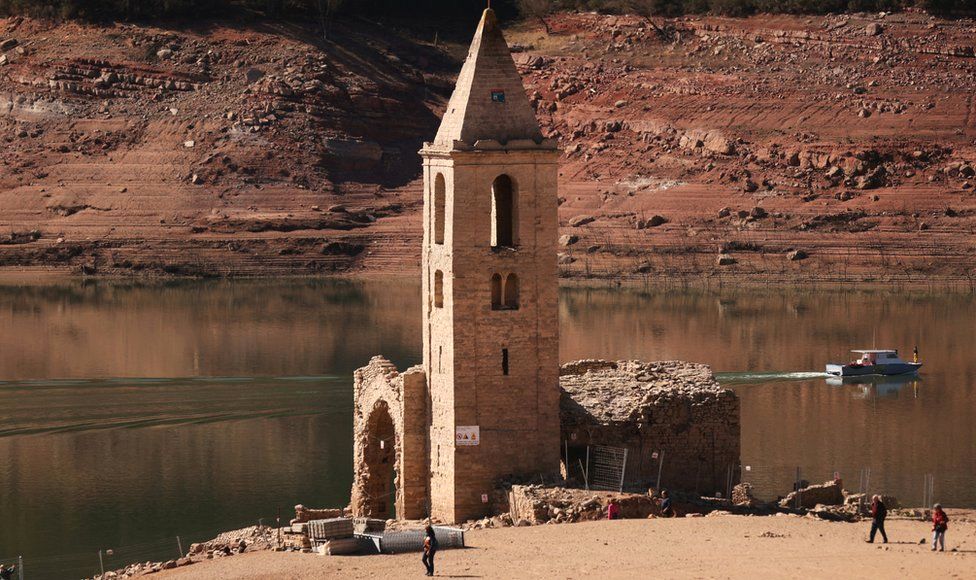Climate change: Catalonia in grip of worst drought in decades
- Published

In the Sau reservoir, teams in small boats are hard at work hauling out fish with nets. The idea is to remove them before they die and rot in the water, making it unusable for human consumption.
The water level has dropped so low here - to below 10% of the reservoir's capacity - that there is already a risk the water will be contaminated by silt. Therefore, while the fish are removed, Sau's remaining water is being emptied downstream to another reservoir.
"We are trying to transfer the water as quickly as we can, because the quality right now in the winter was good [but] in the spring it will become really, really bad, and we're trying to extract all the fish we can find there," said Samuel Reyes, director of the Catalan Water Agency (ACA).
The Sau reservoir, 100km (about 62 miles) inland from Barcelona, has been supplying water to the city and other towns in the north-eastern region of Catalonia for half a century. But in recent months it has become the most visible symbol of the worst drought this area has seen in living memory.
That is because of the now-notorious sight of the 11th Century church of Sant Romà de Sau, which was submerged when the reservoir was created in 1962.
In times of abundant rain, the building - situated in the reservoir - sat below the water level, but it now stands several metres above the waterline, surrounded by parched earth.
This part of Catalonia has not seen sustained rain in two-and-a-half years. In early March, the reservoir's water level had dropped to 8% of its capacity, down from 55% a year earlier.
"I've never seen it so empty," said Agustín Torrent, a 70-year-old man who has lived nearby his whole life and who came to look at the church. "It's sad when you've seen [the reservoir] full before. But that's the way it is. It's climate change and anyone who says it doesn't exist, I don't know what you can say to them."
Although Catalonia's situation is particularly worrying much of the country is facing similar challenges, particularly in southern and eastern areas. In mid-March, reservoirs in the Guadalquivir basin of Andalusia averaged 26% of their capacity, one point below the Catalan interior, and in the south-eastern Segura basin they were at 36%. That compared with 83% capacity in parts of the northwest.
In March, Spain's meteorological agency AEMET declared that the country as a whole "continues in a situation of meteorological drought which began over a year ago".
Not all droughts are caused by climate change, but increased heat in the atmosphere takes more moisture out of the earth, making dry spells worse. The world has warmed by about 1.1C since the beginning of the industrial era and temperatures are expected to keep increasing unless there are drastic cuts to emissions.
In Europe, regions like Catalonia - which is situated on the Mediterranean Sea - are particularly exposed, according to Miguel Manzanares, a Barcelona-based meteorologist who studies extreme weather events on the continent.
"The Mediterranean area is one of the most vulnerable areas when it comes to climate change," he said, identifying countries such as France, Italy, Greece and those in the Balkans as being at high risk. "The Mediterranean Sea is a closed sea, creating its own atmospheric environment."
However, there are other factors which can make droughts worse. In the case of Catalonia, Manzanares said, they include the population of Barcelona and its neighbouring cities, which has risen to more than 5.5 million inhabitants. New restrictions introduced by the Catalan regional government have put strict limits on water use in these areas for washing cars and watering gardens and industrial water usage limits have been cut by 15%.
If we can't plant as many crops... there will be shortages both in Spain and abroad
Spain's extensive use of water for agriculture - accounting for 80% of all water use - is another exacerbating factor. The local government has reduced water use for farming by 40%.
This new limit is an extra problem for farmers in the Barcelona area like Agustín García Segovia, president of the El Prat agricultural co-operative, who have already been struggling with the lack of rain and unseasonably high temperatures.
"If we can't plant as many crops, there will be less product and there will be shortages," he said, standing in a field of artichokes that he is cultivating.
"There will be shortages of products both in Spain and abroad," he added. "And this will also be made felt in price rises."
The Catalan authorities are insisting that no further restrictions are due to be introduced in the short term. However, as the summer approaches, with high temperatures expected and the extra pressure on water resources that the season's tourism brings, they have acknowledged that they are preparing for the worst.
"This is a very critical situation," said Samuel Reyes of the Catalan Water Agency. "This drought in Catalonia is a marathon. The worry is that we are on alert not just for two years or so, but for three or four years."
- Published8 February
- Published27 November 2023
- Published5 November 2022